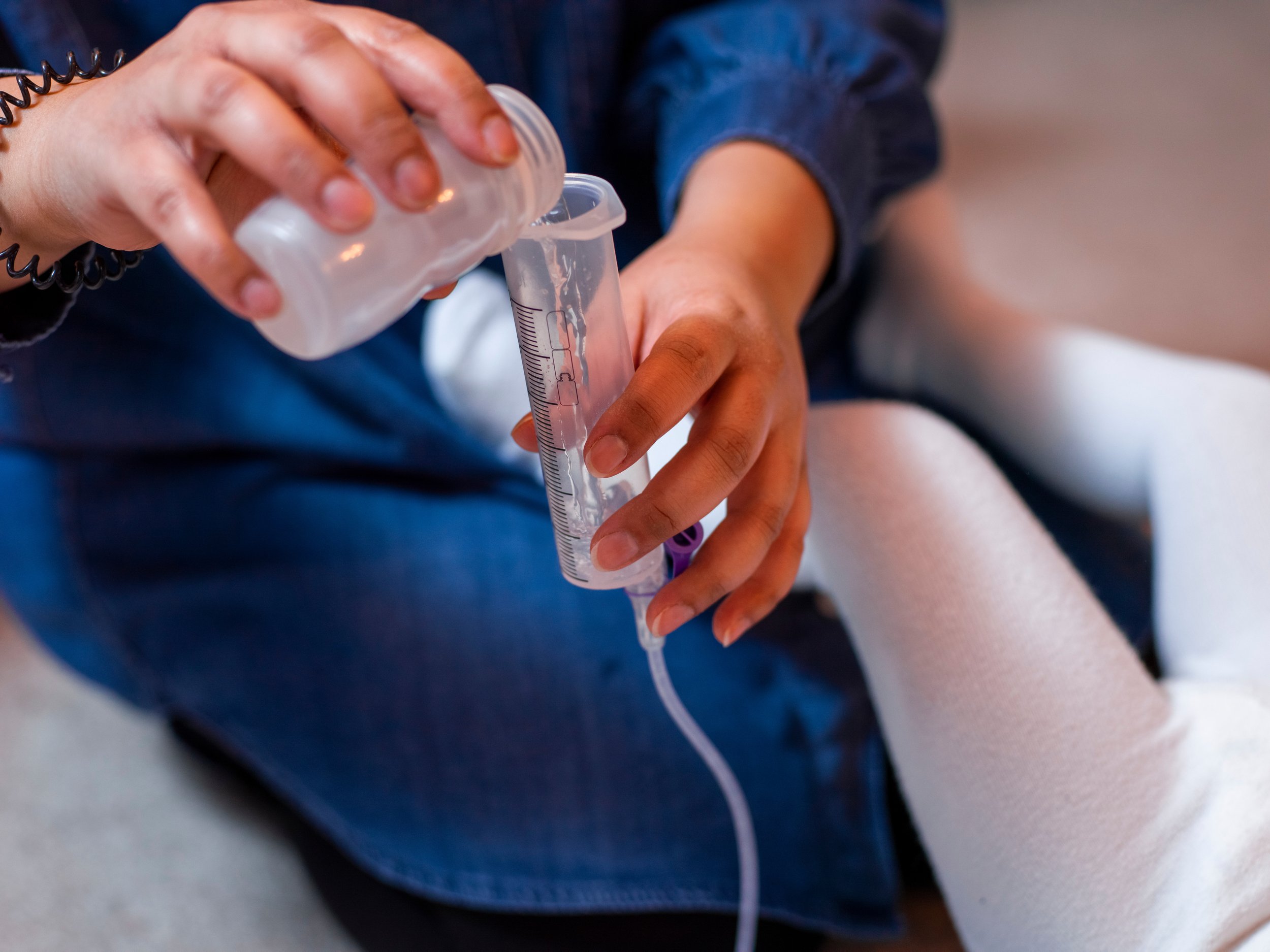
G-tube Care & Maintenance
Daily Feeding Tube Maintenance
-
Flushing the extension tube with water prevents blockages and maintains the integrity of the tube; it is important that you flush your tube after every use (twice a day minimum). Flush your tube with warm water (not hot water). Allow the tube to air dry and store in a clean, dry place. Extension tubes should be replaced every 2 weeks.
-
If your tube becomes blocked DO NOT insert any object into the tube to unblock it, as you may damage the tube. ONLY USE WATER to try to unblock your tube.
1. Check that the feeding tube is not kinked.
2. Gently massage the tube with your fingers if the blockage is visible.
3. If massaging doesn’t work, fill a 60ml syringe with warm water and gently try to flush.
4. If it is still blocked, try pulling back on the plunger of the syringe and hold for 10 seconds, then gently push the plunger forward – this is known as the ‘push-pull’ method.
5. If this is unsuccessful, contact your doctor.
-
Confirm tube positioning prior to use. When connecting the extension set/syringe to the feeding tube, do not apply excessive force or over-tighten the connectors. In most instances, 1/4 turn
is sufficient to connect the ends together. Ensure your child’s head is elevated (minimum 30 degrees) during the feeding and for at least 30 minutes after the feeding.
If your gastrostomy tube has a balloon, confirm how much water is meant to be in your balloon. Check the water volume in the balloon per the manufacturer/health care professional’s instructions.
-
When your child starts gaining weight, the length of the G-tube will need to be increased. Be sure to evaluate the fit of the G-tube daily, when cleaning the stoma site.
Too tight: The G-tube is too tight when it is pressing into the skin, leaving no room in between the skin and the G-tube. If this occurs, contact your doctor to evaluate if you need a longer size.
Too loose: The G-tube is too loose when there is extra room in between the skin and the G-tube when gently lifting, leading to more leaking than usual. If this occurs, contact your doctor to evaluate if you need a shorter size.
Daily Stoma Site Care
-
Always be sure to wash your hands before using the tube and keep the tube, skin, and feeding equipment clean and dry.
-
1. Gently clean the site using a cotton swab or gauze with mild soap and water, twice a day.
2. Remove any drainage crust from the skin and tube.
3. Rinse with clean water and pat dry. Be sure to dry around the tube and under the external bumper.
Note: Do not submerge the site in water (bath or swimming) until the gastrostomy site/skin wound is healed (approximately 2 weeks). Instead, have your child take a sponge bath.
-
If your tube has been stitched in place, you should not attempt to rotate the tube. For other gastrostomy tubes, follow the instructions below.
First 2 Weeks: Do not rotate the tube.
After 2 Weeks: Rotate the tube gently 360 degrees each day to prevent scar tissue from forming.
-
Dressings are not normally required following the insertion of a gastrostomy tube. Never place dressings under the bumper even if there is ooze; this places unnecessary pressure on the gastrostomy site and can lead to complications.
-
Over time you may notice dark pink, fleshy tissue that grows around the stoma site. This is known as proud flesh/granulation tissue and is quite common. It can be left alone unless it causes pain, bleeds, or leaks. If it becomes a problem, talk to your doctor or nurse. Ensure clean hands before touching the tube or site.
Monitor for Signs & Symptoms of Infection
Signs of an infection that may appear at or around the G-tube site with or without fever include the following:
Redness
Swelling or pain around the site
Yellow-green or foul-smelling discharge
Firm or Hard Spots
Site is warm to the touch
Infection Control Tips
-
Always wash your hands with soap and water prior to touching the g-tube site, feeding equipment, or formula. While gloves are not mandatory, it is important to cover any open wounds on your fingers, hands, or wrists prior to caring for a person’s G-tube or feeding equipment.
-
Use the feeding equipment properly as instructed per manufacturer’s guidelines.
-
Feeding bags: Rinse with warm water after each feeding and discard after 24 hours.
Extension sets: Flush after each use and replace every few weeks at a minimum.
-
Formula, once opened, is at risk for bacteria contamination. Check expiration dates and talk to your dietitian or nurse about the length of time your formula can safely hang in a feeding bag.
